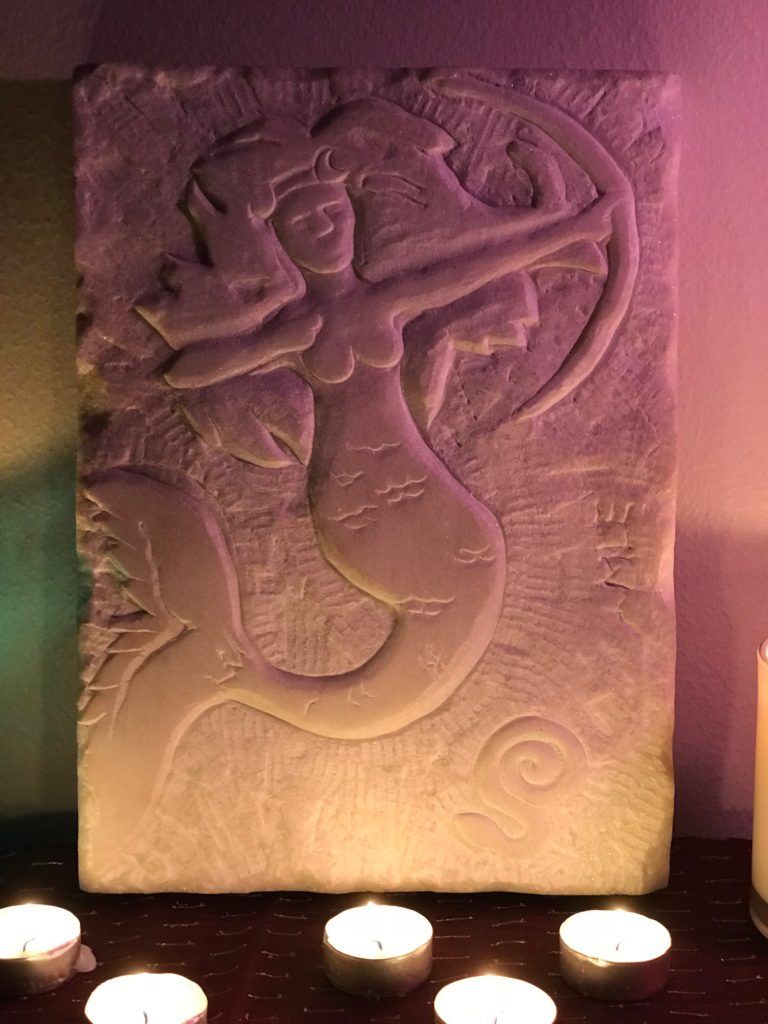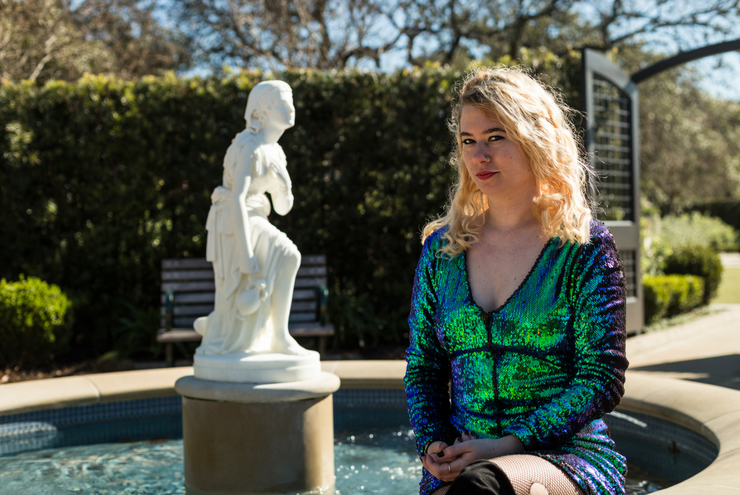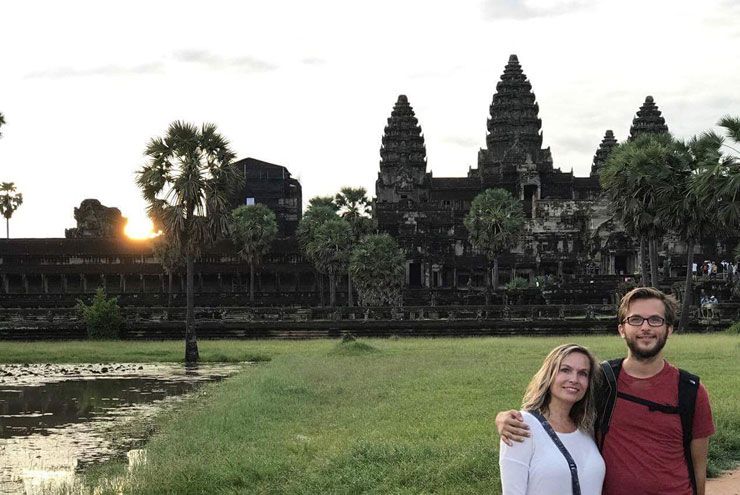By MLe McWilliams
“The discovery of a mythical pattern that in some way one feels is connected to one’s own life deepens one’s self understanding. At the same, the discovery of the personal significance of a mythic pattern enhances our understanding of the myth and its variations.” –Christine Downing, The Goddess: Mythological Images of the Feminine
Crowded around a makeshift table in the middle of the gallery, we began to pour wine and feast on spaghetti. Surrounding me were seven other students who, like myself, had chosen to study abroad in Athens, Greece, as well as eight local elders. The night marked the last of our semester-long traditional marble carving class and celebration was in the air. Towards the end of the night, our instructor, Demetris, asked us each to share the marble carvings we had created.
Four months prior, on our first night of class, Demetris taught us that the carving we created should represent something symbolic and important to us, as it will last forever. Artists also deeply connect with marble as a medium, he explained, because it emulates our skin—the veins that run through it would mirror our own. Thus, the image I carved should be a representation of myself in my marble skin.
Throughout my time in Athens, I visited the studio once a week for four hours, chipping away into the marble. In the end, I had created a sculpture entitled, Artemis the Mermaid with Aspects of Medusa. In my marble skin, I carved the body of a fierce and powerful mermaid, her face and bare chest confronting the viewer, her arms drawing back her bow, ready to shoot. Her wild hair flows around her, a tiny snake slithering through it, and a moon crown adorns her head. By her side is a serpent, coiled and poised.

‘Artemis the Mermaid with Aspects of Medusa’ by MLe McWilliams. Photo by MLe McWilliams.
I’ve always loved and identified with mermaids, so I knew right away that I wanted to carve one into my marble. However, I also feel a deep connection to both Artemis and Medusa, two figures whose meanings drastically differ from mermaids. As a result, I decided to create a hybrid goddess to reflect my personal conflicting identities. I incorporated all three mythological symbols into one and carved them all into my stone skin.
Each of these three mythological figures have their own unique associations and meanings. In the marble carving, the body of the goddess is symbolic of a mermaid—a creature that is known for being autonomous, sexual, and dangerous because of its close association with the Greek sirens who use their bodies and songs to lure men to their deaths. Because mermaids/sirens are overtly sexual, pleasure only themselves, and are not able to sexually please their victims (because they don’t have genitals), patriarchal societies would deem them “whores.”
The second mythological figure I incorporated into my carving was the Greek goddess Artemis. Artemis is depicted as the moon crown that encircles the mermaid’s hair, as well as the bow she has drawn. In mythology, Artemis is the virgin goddess of the hunt and wild. Her domain is the virgin forests where she and her band of maidens live. As a child, Artemis wished to remain a virgin forever, and thus, her body remains untouched and unseen by men—leading her to be designated as the pure and virgin goddess.
The last symbol I integrated into my sculpture was that of the Greek monster Medusa. I wove Medusa’s snakes into the mermaid, one in her hair and one by her side. In Greek mythology, Medusa is a female monster who has snakes for hair and whose stare turns men to stone. Medusa was cursed into her gorgon body because she was sexually assaulted by Poseidon in the temple of Athena, violating the purity of the temple. Because of this sexual assault—which tarnished and shamed her body—she was transformed into the ugly, horrible monster we understand her to be. This story helps illustrate that, even today, sexual assault is still seen as the fault of the victim, and they are punished accordingly.
I incorporated symbols of all three of these beings into my carving because I can understand aspects of my own identity through each of their mythological bodies. I am the mermaid/siren in terms of how I own my sexuality. I aim to only please myself sexually, and consider myself to be an autonomous and dominant woman. This perception manifests in the way I dress and dance. While abroad in Greece, I wore clothes that would be considered provocative or sexy out to bars and clubs. Once there, I would dance the tsifteteli, a sensual dance traditional to Greek women. This dance caught the eyes of male clubgoers, which resulted in praise, lust, and free alcohol. One of the local bartenders even nicknamed me “the dancer,” and, when I was absent, he would ask my friends where his dancer was. Even one of the elders in my marble carving class lusted after me, carving me as a naked maiden bathing in a waterfall into his own sculpture. My experiences being fetishized and sexualized (mostly by men) have culminated in a better understanding of how my identity relates to the mermaid/siren—a creature that is visually pleasurable to men, but will never be owned by them.
At the same time, I am also Artemis, the virgin goddess of the wild and protectress of women and girls. Even though I choose to dress and dance in ways that may be considered overly sexual, I identify as asexual and am, therefore, defined by our patriarchal society as a virgin—pure and untouched sexually by men or women. I view Artemis as similarly asexual, as she chooses to remove herself from the male gaze altogether. Artemis also protects women and girls, accompanying them through transitional phases of their lives, which I can relate to in my own personal feminism.
Lastly, I am Medusa, the powerful, ugly, and angry victim. Medusa was once a beautiful priestess of Athena before she was sexually assaulted and turned into an abhorrent gorgon. When I was in Greece, a friend and I were violently beaten and violated by two men who targeted us because we were young, American women. I became angry and upset—not only at the violation of my body, but of my space and sense of safety—just like Medusa. In the eyes of our society, I became a victim, an identity looked down upon and shamed.
All three of these mythological figures were created in a patriarchal society. Each are traditionally seen as objects to be controlled and oppressed. However, if we begin to use divergent thinking, or the movement away from the hegemonic binary to a holistic way of thinking, we can see these three representations of woman as taking ownership over their own bodies, refusing to let men control or dominate them. While mermaids/sirens use their bodies to entice men, they are concerned only with their own pleasure. This autonomy and pleasure seeking can be seen as a great source of power. I too, use my body as a tool to advance my own pleasure and interests. Artemis’ virgin status also gives her power over men—though she is desired, she does not let men see or touch her body. Although I may act seductive, I don’t allow men (or women) to sexually touch my body, which is a form of personal power and control. Lastly, even though Medusa was transformed into a monstrous gorgon, she used her cursed body to express her pain. I believe that, when men looked into Medusa’s eyes, they were turned to stone because they saw the horror and pain the patriarchal society has inflicted upon those who do not follow gendered and heteronormative ideals. Through this lens, Medusa both accepts and displays herself as a victim, but also positions herself as strong, resilient warrior.
After I completed my carving, my marble skin, I wondered, how can all of these conflicting attributes coexist in my body? How can I be all of these conflicting selves at once? I further explored this concept for my undergraduate anthropology thesis paper. In this paper, I developed a theory I call the “multitude of selves.” The multitude of selves are the many identities and personalities one creates and performs as they encounter different people and situations relative to their world. Because they are created by a mixture of complacency and rebellion against cultural hegemonic norms, a person’s collection of selves can be both similar and conflicting. Within this multitude of selves is my own personal “multitude of conflicting selves,” a subgroup of selves that have actions, feelings, beliefs, and behaviors that differ from one another. This collection of selves has emerged in response to the hegemonic ideas of gender and sexuality, which I follow, reproduce, create, and rebel against. By reconciling and embracing my multitude of conflicting selves, I was able to fully understand my identity and began to think divergently. Through divergent thinking, people can learn to accept their multitude of selves, conflicting and all, and to create new outlets for expression and discourse.
Carving my marble skin allowed me to open my mind, to express my multitude of conflicting selves, and to create a figurative body in which to house and embrace them. As a result, I have refused to be an either/or. Instead, I am a both/and. I have a multitude of conflicting selves—I am both a virgin and a whore, sexual and asexual, a warrior and a victim, a mortal and a goddess, a follower and a rebel, beautiful and ugly, masculine and feminine, dominant and submissive, all present in this body. By categorizing women as either a virgin or a whore, a victim or a warrior, we are placing women within the binary, which disrupts and confuses their identity. However, if we begin to use divergent thinking and, in turn, to accept and celebrate these multitudes of conflicting selves, it will allow women the chance to better understand their truths, identities, and the world around them.







